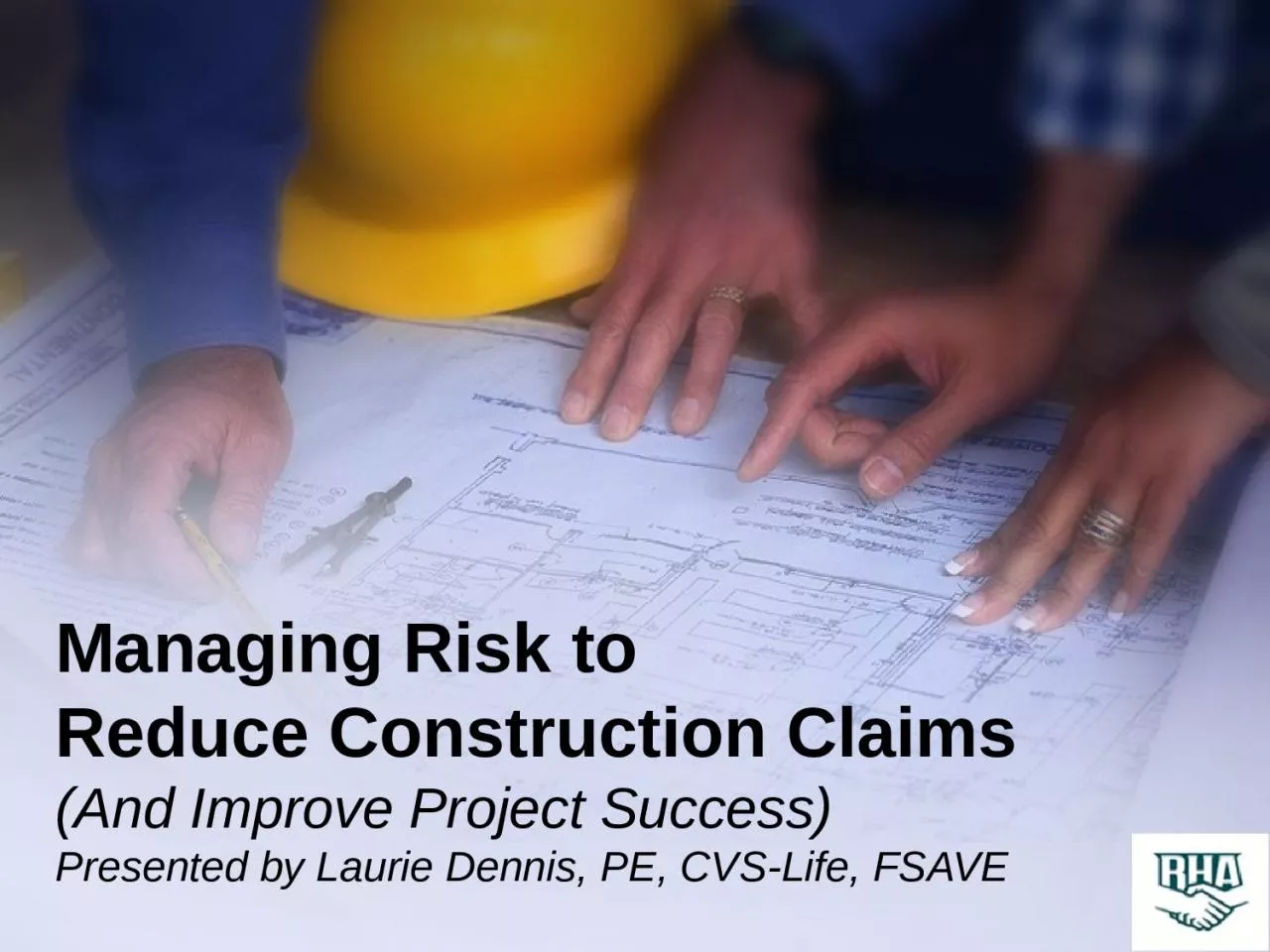

And Improve Project Success Presented by Laurie Dennis PE CVSLife FSAVE Presentation Objectives What is the definition of project r isk Why managing risk is important When to use risk ID: 1029888
Download Presentation The PPT/PDF document "Managing Risk to Reduce Construction Cl..." is the property of its rightful owner. Permission is granted to download and print the materials on this web site for personal, non-commercial use only, and to display it on your personal computer provided you do not modify the materials and that you retain all copyright notices contained in the materials. By downloading content from our website, you accept the terms of this agreement.
1. Managing Risk to Reduce Construction Claims(And Improve Project Success)Presented by Laurie Dennis, PE, CVS-Life, FSAVE
2. Presentation ObjectivesWhat is the definition of project riskWhy managing risk is importantWhen to use risk assessmentsAn overview of the risk assessment processHow to identify and assess riskTreating the riskManaging the risk assessment processIntegrating risk into your organization
3. What Is The Cause?Escalating construction costs due to:Incomplete plansDesign issues not mitigated and pushed into constructionConstrained design schedules; issues not resolvedVery little discussion of risk and impactsNot understanding the true impacts related to the risk
4. What is a RiskAn uncertain event or condition that, if it occurs, has a positive or negative effect on at least one project objective. A risk may have one or more causes and, if it occurs, one or more impacts.
5. Threats vs OpportunitiesA negative risk is described as a Threat – causing an adverse impact on a project goal. A positive risk is described as an Opportunity – causing a positive impact on a project goal.
6. What is a RiskRisk can typically be divided into the following three categories; Political – this can be defined as communities, permitting, management priorities, users, approvals, media, and internal stakeholders/ project team issues.Technical – this is the most common for design and construction projects and is typically represented by requirements, regulatory, technology, data, design, construction, maintenance, operations, life cycle asset management, and cost. (i.e., health, safety, environmental, etc.)
7. What is a RiskContractual – this is most commonly related to funding, negotiations, scope of work, qualification requirements, certification requirements, incentives, penalties and defaults.
8. Importance of Managing Project RiskAvoid and/or minimize adverse impactsPlanningDesignConstructionCommissioningMaximize opportunities to improve project objectivesAvoid and/or minimize management by crisisBetter decision-making; understanding all impactsHelp keep management apprised of project issues
9. Risk and Project ManagementAll phases will benefit from the analysisPlanningProgrammatic decision-makingFormulates initial approaches to determine level of effort and potential cost implicationsProject InitiationDeveloping project scope/complexityBudgetary impactsProject Feasibility/Pre-DesignReducing potential risks during concept developmentAlternative selection
10. Risk and Project ManagementDesignManaging project risksMinimizes construction impacts (cost & schedule)Construction and CommissioningDuring the Partnering sessionInforms construction of risks identified through the design processProvides new information from a contractors perspective – helps to reduce or eliminate risks impacting the schedule, budget and deliveryIdentifies potential impacts to avoid commissioning problems and challenges
11. Risk and Project ManagementAlternative DeliveryGCCM/CMARUsed by the GCCM/CMAR team to develop an understanding and provide ideas for risk mitigation in their proposalsFormalized workshop with all partiesDesign/Build Used by the owner developing and finalizing the RFP documentsUsed by the D/B team to develop an understanding and provide ideas for risk mitigation in their proposals
12. What is a Risk AssessmentIt is a focused effort to discover and act on risks and opportunities that can affect a project’s scope, schedule, budget or quality early in the project and continuously throughout the project life cycle.It is a quantitative and qualitative approach to identifying risk, which includes both the negative sides of risk and opportunities, and evaluates the likelihood and potential impact.
13. Risk ApproachesQuantitative – electronically modeling the project schedule and/or cost estimate. Uses a Monte Carlo-type simulation. Qualitative – using a simplified tool, such as a risk register to identify and then track, using an order of magnitude impact to cost and schedule.
14. Risk Assessment ProcessPlanning for the WorkshopInitial Risk Assessment WorkshopStand-alone Jointly with a value engineering studyRisk Register UpdatesFollow-up WorkshopsRisk Database UpdatesTransfer Risk Information to ConstructionCombine with a Partnering workshopPart of the project start-up
15. Risk Assessment ProcessWith Value Engineering Study Identify Risks Evaluate Risks Using Risk Register Creative Mitigation or Elimination Risk Develop Ideas Define Potential Impacts
16. Risk Assessment ProcessProject Close-outUpdate the risk database (knowledge transfer)
17. Continuous Improvement Cycle
18. Risk PlanningInformation and Data GatheringStakeholder Identification and InvolvementRisk Assessment TeamDetermine Level of Project ComplexityHigh complexity/consequencesHigh importanceReview Existing DataIncluding the Risk DatabaseWorkshop LogisticsWorkshops/Meetings
19. Risk Identification and Analysis
20. Status of RiskThreatsAvoid/Eliminate Clarifying requirements, obtain information, improve communication, acquire expertise.Transfer/Share Gives the risk to a third party, does not eliminate the potential costs or exposure. Where is the best place for the risk to borne.Mitigate/Reduce the LikelihoodAcceptThere are many risks that will occur regardless of mitigation measures, these are accepted and then accounted for in the scope, schedule and budget.
21. Status of RiskOpportunitiesAccept – Ensure that the opportunity is realized. Might include escalating a schedule for early completion.Share – Apportioning ownership between two or more. Might include using performance specifications.Enhance – Increasing the probability that it will occur. Might include facilitating the cause to increase the probability.
22. Treating the Risk
23. Managing the PlanManage and update the risk register and treatment planTrack assignments for completionMonitor the “watch list”Decision-making and keeping management informed
24. Integrating Risk AssessmentsEstablish a formal process and integrate into your project management planEstablish a risk data-base Identify a risk coordinator for each project (May be the Project Manager)Establish management support and “buy in”Track statistics and share the data to support the process and the successes
25. Questions
26. Presenter Laurie Dennis, PE, CVS-Life, FSAVE RHA, LLC (206) 200-9798 email: lmdennis@earthlink.net